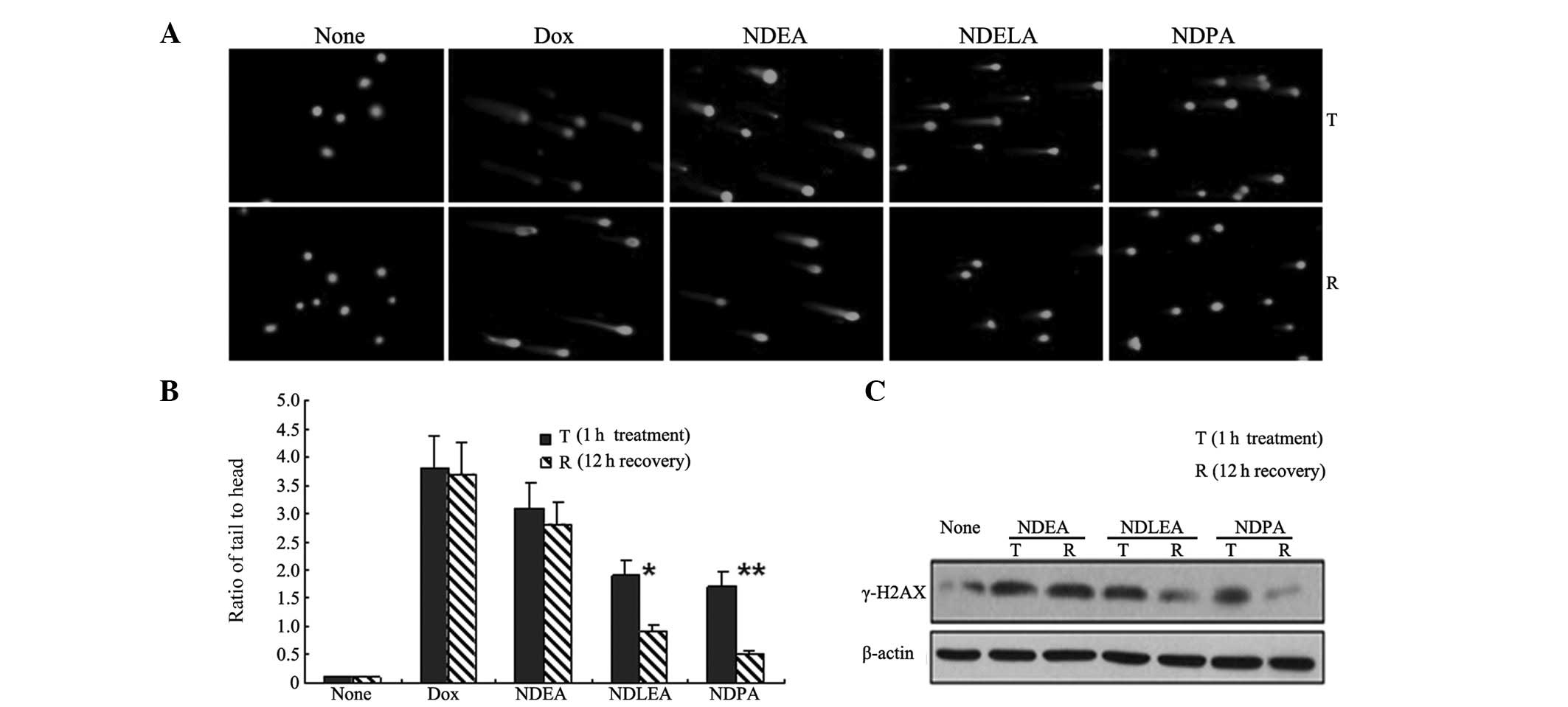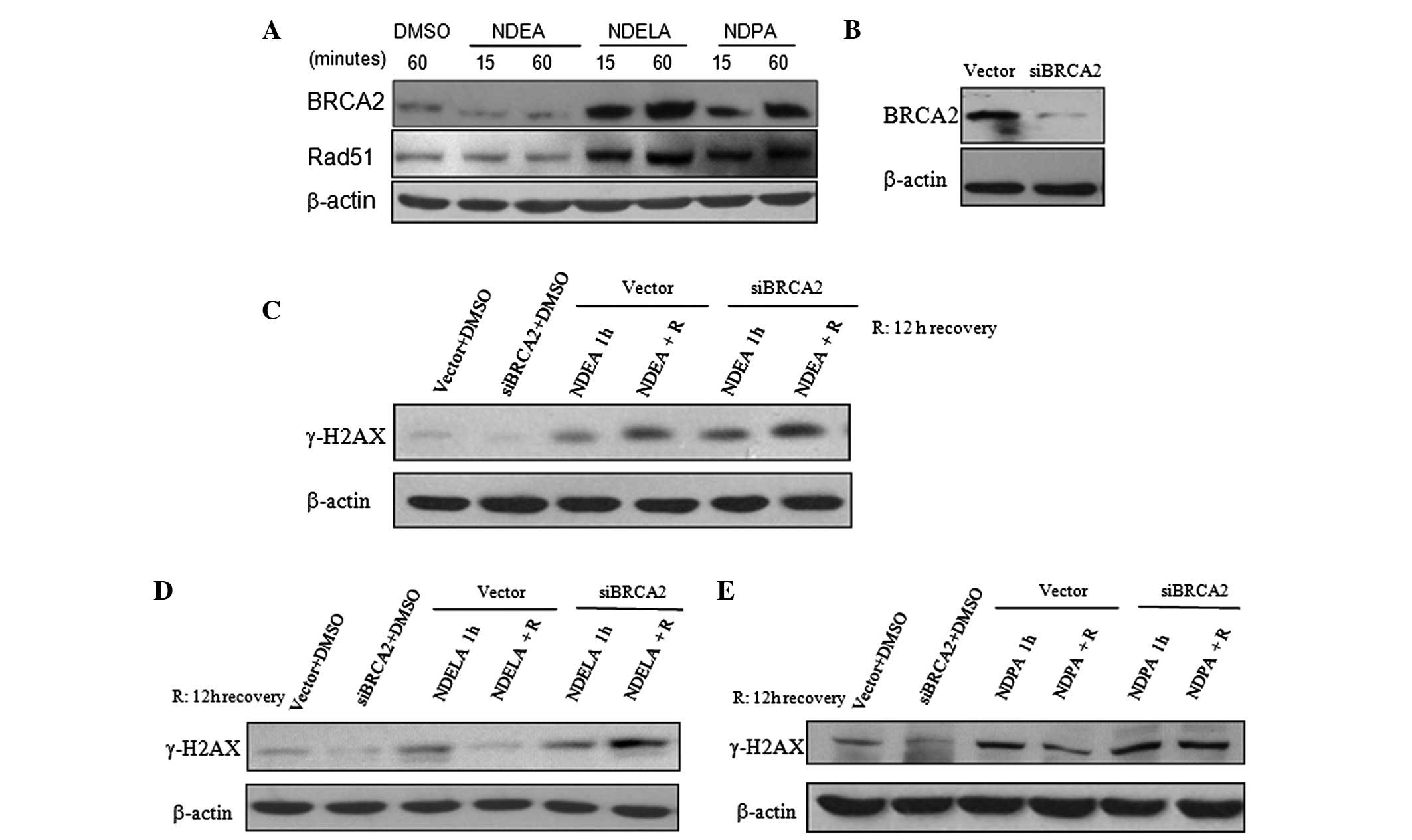|
1
|
Wooster R, Bignell G, Lancaster J, et al:
Identification of the breast cancer susceptibility gene BRCA2.
Nature. 378:789–792. 1995. View
Article : Google Scholar : PubMed/NCBI
|
|
2
|
Tavtigian SV, Simard J, Rommens J, et al:
The complete BRCA2 gene and mutations in chromosome 13q-linked
kindreds. Nat Genet. 12:333–337. 1996. View Article : Google Scholar : PubMed/NCBI
|
|
3
|
Jakubowska A, Nej K, Huzarski T, Scott RJ
and Lubiński J: BRCA2 gene mutations in families with aggregations
of breast and stomach cancers. Br J Cancer. 87:888–891. 2002.
View Article : Google Scholar : PubMed/NCBI
|
|
4
|
Venkitaraman AR: Cancer susceptibility and
the functions of BRCA1 and BRCA2. Cell. 108:171–182. 2002.
View Article : Google Scholar : PubMed/NCBI
|
|
5
|
Liede A, Karlan BY and Narod SA: Cancer
risks for male carriers of germline mutations in BRCA1 or BRCA2: a
review of the literature. J Clin Oncol. 22:735–742. 2004.
View Article : Google Scholar : PubMed/NCBI
|
|
6
|
Patel KJ, Yu VP, Lee H, et al: Involvement
of Brca2 in DNA repair. Mol Cell. 1:347–357. 1998. View Article : Google Scholar : PubMed/NCBI
|
|
7
|
Moynahan ME, Pierce AJ and Jasin M: BRCA2
is required for homology-directed repair of chromosomal breaks. Mol
Cell. 7:263–272. 2001. View Article : Google Scholar : PubMed/NCBI
|
|
8
|
O’Donovan PJ and Livingston DM: BRCA1 and
BRCA2: breast/ovarian cancer susceptibility gene products and
participants in DNA double-strand break repair. Carcinogenesis.
31:961–967. 2010.PubMed/NCBI
|
|
9
|
Bryant HE, Schultz N, Thomas HD, et al:
Specific killing of BRCA2-deficient tumours with inhibitors of
poly(ADP-ribose) polymerase. Nature. 434:913–917. 2005. View Article : Google Scholar : PubMed/NCBI
|
|
10
|
Wang W and Figg WD: Secondary BRCA1 and
BRCA2 alterations and acquired chemoresistance. Cancer Biol Ther.
7:1004–1005. 2008. View Article : Google Scholar : PubMed/NCBI
|
|
11
|
Thompson LH and Schild D: Homologous
recombinational repair of DNA ensures mammalian chromosome
stability. Mutat Res. 477:131–153. 2001. View Article : Google Scholar : PubMed/NCBI
|
|
12
|
Pellegrini L and Venkitaraman A: Emerging
functions of BRCA2 in DNA recombination. Trends Biochem Sci.
29:310–316. 2004. View Article : Google Scholar : PubMed/NCBI
|
|
13
|
Shivji MK and Venkitaraman AR: DNA
recombination, chromosomal stability and carcinogenesis: insights
into the role of BRCA2. DNA Repair (Amst). 3:835–843. 2004.
View Article : Google Scholar : PubMed/NCBI
|
|
14
|
Ohnishi T, Mori E and Takahashi A: DNA
double-strand breaks: their production, recognition, and repair in
eukaryotes. Mutat Res. 669:8–12. 2009. View Article : Google Scholar : PubMed/NCBI
|
|
15
|
Davies AA, Masson JY, McIlwraith MJ, et
al: Role of BRCA2 in control of the RAD51 recombination and DNA
repair protein. Mol Cell. 7:273–282. 2001. View Article : Google Scholar : PubMed/NCBI
|
|
16
|
Foster ER and Downs JA: Histone H2A
phosphorylation in DNA double-strand break repair. FEBS J.
272:3231–3240. 2005. View Article : Google Scholar : PubMed/NCBI
|
|
17
|
Esashi F, Galkin VE, Yu X, et al:
Stabilization of RAD51 nucleoprotein filaments by the C-terminal
region of BRCA2. Nat Struct Mol Biol. 14:468–474. 2007. View Article : Google Scholar : PubMed/NCBI
|
|
18
|
Rogakou EP, Pilch DR, Orr AH, Ivanova VS
and Bonner WM: DNA double-stranded breaks induce histone H2AX
phosphorylation on serine 139. J Biol Chem. 273:5858–5868. 1998.
View Article : Google Scholar : PubMed/NCBI
|
|
19
|
van Attikum H, Fritsch O, Hohn B and
Gasser SM: Recruitment of the INO80 complex by H2A phosphorylation
links ATP-dependent chromatin remodeling with DNA double-strand
break repair. Cell. 119:777–788. 2004.PubMed/NCBI
|
|
20
|
Pellegrini L, Yu DS, Lo T, et al: Insights
into DNA recombination from the structure of a RAD51-BRCA2 complex.
Nature. 420:287–293. 2002. View Article : Google Scholar : PubMed/NCBI
|
|
21
|
Powell SN and Kachnic LA: Roles of BRCA1
and BRCA2 in homologous recombination, DNA replication fidelity and
the cellular response to ionizing radiation. Oncogene.
22:5784–5791. 2003. View Article : Google Scholar : PubMed/NCBI
|
|
22
|
Filho PJ, Rios A, Valcárcel M and Caramao
EB: Development of a new method for the determination of
nitrosamines by micellar electrokinetic capillary chromatography.
Water Res. 37:3837–3842. 2003. View Article : Google Scholar : PubMed/NCBI
|
|
23
|
Brambilla G and Martelli A: Genotoxic and
carcinogenic risk to humans of drug-nitrite interaction products.
Mutat Res. 635:17–52. 2007. View Article : Google Scholar : PubMed/NCBI
|
|
24
|
Hecht SS: Approaches to cancer prevention
based on an understanding of N-nitrosamine carcinogenesis. Proc Soc
Exp Biol Med. 216:181–191. 1997. View Article : Google Scholar : PubMed/NCBI
|
|
25
|
Williams GM, Iatropoulos MJ, Jeffrey AM,
Luo FQ, Wang CX and Pittman B: Diethylnitrosamine
exposure-responses for DNA ethylation, hepatocellular
proliferation, and initiation of carcino-genesis in rat liver
display non-linearities and thresholds. Arch Toxicol. 73:394–402.
1999. View Article : Google Scholar
|
|
26
|
Pinto LF, Moraes E, Albano R, et al: Rat
oesophageal cytochrome P450 (CYP) monooxygenase system: comparison
to the liver and relevance in N-nitrosodiethylamine carcinogenesis.
Carcinogenesis. 22:1877–1883. 2001. View Article : Google Scholar
|
|
27
|
Visoni S, Lang M and Ribeiro Pinto LF:
Hamster exhibits major differences in organ-specific metabolism of
the esophageal carcinogen N-nitrosodiethylamine. Toxicol Lett.
183:90–94. 2008.PubMed/NCBI
|
|
28
|
International Agency for Research on
Cancer (IARC): Overall evaluations of carcinogenicity: an updating
of IARC Monographs volumes 1 to 42. IARC Monogr Eval Carcinog Risks
Hum. Suppl 7:1–440. 1987.PubMed/NCBI
|
|
29
|
International Agency for Research on
Cancer (IARC): Some N-Nitroso Compounds. IARC Monogr Eval Carcinog
Risks Hum. 17:1–365. 1978.
|
|
30
|
International Agency for Research on
Cancer (IARC): Tobacco habits other than smoking; betel-quid and
areca-nut chewing; and some related nitrosamines. IARC Working
Group Lyon, 23–30 October 1984. IARC Monogr Eval Carcinog Risk Chem
Hum. 37:1–268. 1985.PubMed/NCBI
|
|
31
|
Bradley MO, Dysart G, Fitzsimmons K,
Harbach P, Lewin J and Wolf G: Measurements by filter elution of
DNA single- and double-strand breaks in rat hepatocytes: effects of
nitrosamines and gamma-irradiation. Cancer Res. 42:2592–2597.
1982.PubMed/NCBI
|
|
32
|
Loeppky RN, Ye Q, Goelzer P and Chen Y:
DNA adducts from N-nitrosodiethanolamine and related beta-oxidized
nitrosamines in vivo: (32)P-postlabeling methods for glyoxal- and
O(6)-hydroxyethyldeoxyguanosine adducts. Chem Res Toxicol.
15:470–482. 2002. View Article : Google Scholar
|
|
33
|
Wiltshire T, Senft J, Wang Y, et al: BRCA1
contributes to cell cycle arrest and chemoresistance in response to
the anticancer agent irofulven. Mol Pharmacol. 71:1051–1060. 2007.
View Article : Google Scholar : PubMed/NCBI
|
|
34
|
Wang Y, Wiltshire T, Senft J, et al:
Fanconi anemia D2 protein confers chemoresistance in response to
the anticancer agent, irofulven. Mol Cancer Ther. 5:3153–3161.
2006. View Article : Google Scholar : PubMed/NCBI
|
|
35
|
Fillingham J, Keogh MC and Krogan NJ:
GammaH2AX and its role in DNA double-strand break repair. Biochem
Cell Biol. 84:568–577. 2006.PubMed/NCBI
|
|
36
|
Dickey JS, Redon CE, Nakamura AJ, et al:
H2AX: functional roles and potential applications. Chromosoma.
118:683–692. 2009. View Article : Google Scholar : PubMed/NCBI
|
|
37
|
Phillips ER and McKinnon PJ: DNA
double-strand break repair and development. Oncogene. 26:7799–7808.
2007. View Article : Google Scholar : PubMed/NCBI
|
|
38
|
Hefferin ML and Tomkinson AE: Mechanism of
DNA double-strand break repair by non-homologous end joining. DNA
Repair (Amst). 4:639–648. 2005. View Article : Google Scholar : PubMed/NCBI
|
|
39
|
Schoenfeld AR, Apgar S, Dolios G, Wang R
and Aaronson SA: BRCA2 is ubiquitinated in vivo and interacts with
USP11, a deubiquitinating enzyme that exhibits prosurvival function
in the cellular response to DNA damage. Mol Cell Biol.
24:7444–7455. 2004. View Article : Google Scholar : PubMed/NCBI
|
|
40
|
Philip S, Swaminathan S, Kuznetsov SG, et
al: Degradation of BRCA2 in alkyltransferase-mediated DNA repair
and its clinical implications. Cancer Res. 68:9973–9981. 2008.
View Article : Google Scholar : PubMed/NCBI
|














